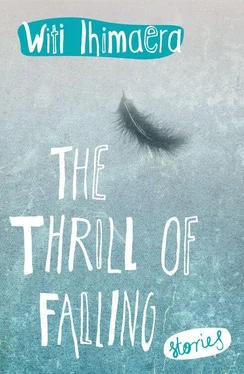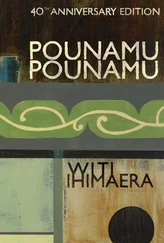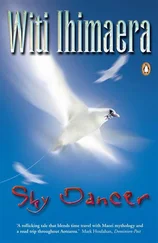‘Gee, Koro,’ I would tease, ‘how many of those did you steal from Wellington Public Library this week?’
‘Concentrate on your homework,’ he would growl.
To help pay for my studies, I got a part-time weekend job cleaning windows, but, hold on, these weren’t just any old windows and not from the inside either. No, they were high tower buildings and some of those windows were thirty storeys high.
Bilbo — sorry, Alapati — got me the job. You may have seen us, lowering ourselves down the buildings on scaffolding, hooked on safety lines like mountaineers. Alapati knew I had a good head for heights, and he and I liked to swing like monkeys across from one side of the building to the other. On my part, the big plus was the money, so, after I got my certification, there I was, earning more than most of my mates and, as well, doing law.
Jean-Luc saw me one day. ‘You are fearless too?’ he asked. ‘Are you not afraid you might fall?’
The thought had never entered my head.
Yes, and sometimes, something arose at university to remind me of Tupaea. During a history lecture, for instance, while the professor was talking about Captain Cook’s voyages throughout New Zealand, I was looking through his words and wilfully reading the history my way, Koro’s way.
‘Throughout the rest of his stay Tupaea captained the Endeavour on a circumnavigation of Aotearoa. Wherever he went the people cried out, “Tupaea! Tupaea! Welcome Tupaea, ariki no Hawaiki!”
‘Sometimes he tried to warn them about the red and white strangers. He often succeeded. On occasion, he didn’t. But they were magnanimous in their forgiveness; after all, the goblins and tricksters were under his protection.
‘The circumnavigation proved that there was no great southern continent. Cook’s masters in Great Britain had thought that the eastern coast of Aotearoa was its edge; they should have asked Tupaea as he would have told them it did not exist.
‘Near the end of the voyage, while the Endeavour lay at anchor in the sparkling waters of Waitangi, Tupaea invited Ngapuhi chiefs on board. The chiefs exchanged gifts of cloaks and mere with their visitor from Hawaiki.
‘Then came the time when Tupaea told them, “E’oa ma, e ’aere ana au.” His sojourn among them was ended.
‘The news was carried from one height to the other across Aotearoa, and a huge ululation of sadness and grief sounded even unto Te Raituitai, the highest heaven, as they beseeched ’Oro: “Will you not allow your priest to stay with us?”
‘War canoes accompanied Tupaea’s ship Endeavour to the horizon. There, flocks of birds were hovering, ready to accompany the priest onward and away.
‘Tupaea set his face northward. Finally, he was bound for England.’
I thought my version was better.
And, another time, the God ’Oro suddenly popped into my head during a philosophy lecture.
We had a guest from Europe who was talking about ancient myths. I thought of Four-Eyes Wilson — if he could see me now.
Then the lecturer said something interesting. ‘Of course, today, there are still many societies for whom the myths of Olympus or Valhalla, of gods, goddesses and one-eyed monsters, are still as real and as relevant as they were in ancient times.’
The lecture hall rippled with amusement. ‘What or how,’ the lecturer continued, ‘would they feel if Cyclops, say, had survived the ages of man and lived in a cave on Mount Olympus … or even here, in New Zealand, near Invercargill! Our rational mind would refuse to admit that possibility, but what if?’
As the laughter rose I thought to myself:
‘Mate, you don’t know the half of it. Maori still live with their own versions of Cyclops. Mine had his house in a cave at the back of Uawa where he slept in an ironwood cylinder and was kept warm by a royal loincloth of red feathers. Now he’s in a storage unit in Porirua.’
3
Then, one evening, I went to train at the gym but discovered a CLOSED sign on it and the words CONFIDENTIAL PRIVATE SESSION. Puzzled, I shrugged my shoulders and turned down the corridor. As I was leaving I saw Thierry. ‘What’s this about?’ I asked.
‘My father is taking a special clinic for a gymnast from overseas. He arrived this afternoon from Europe and he returns tomorrow.’
‘He’s here for just one night?’ I was accustomed to visitors turning up at the gym. Some of them were world-class athletes who were perfecting some routine. Others wished to train for a routine that was beyond them, and wanted Jean-Luc to help them achieve a breakthrough. Or, more seriously, they required remedial work after some injury.
This secrecy was different. ‘I can ask Father if we can watch if you like,’ Thierry said.
I followed him past the sign and into the gym. Jean-Luc was taking the visiting gymnast through some conditioning and stretch exercises. Thierry spoke to him and pointed me out. Jean-Luc hesitated and asked the gymnast. At first he shook his head, but then he made a small moue, okay.
The gymnast went back to the conditioning and stretching, Jean-Luc speaking quietly and insistently to him. ‘No, you must continue! Thirty more repetitions! No, is still not enough! Fifty more stretches so that when you pump up you can reach maximum chest expansion! Your body is not at the level it needs to be to guarantee the excellence of your performance! Comprends?’
Not until Jean-Luc was satisfied did he allow the gymnast to complete the warm-up. And as he stood, Jean-Luc was measuring the gymnast’s chest, biceps, thighs and manipulating his feet and massaging the ankles. ‘Okay? We get in the harness now and you show me what you do.’
The gymnast turned, lifted his arms, and Jean-Luc fitted the harness to him. ‘Yes, Maître,’ he nodded. It was that action of lifting his arms that allowed me to recognise him:
He was the famous aerialist, Maurice Sernas, of Le Cirque du Monde, one of the most spectacular international circuses in the world.
‘What is Sernas doing in New Zealand?’ I asked Thierry, as I watched the aerialist approach a hanging rope. I’d noticed the rope many times before, but it was usually rolled tightly within the rafters.
‘He’s halfway through a tour with his new act, Boléro , for the Grand Chapiteau, the big top, and he has struck trouble with the performance. Circus acts depend on split-second timing and if one performer is out of synch he can destroy the entire choreography of the others. So Sernas has come to Father for a diagnosis.’
‘Why Jean-Luc?’ I asked.
‘Sernas is a former student of my father’s,’ Thierry answered, looking at me as if I was stupid. ‘Jean-Luc is the world expert in the corde lisse.’
The corde lisse!
It is considered the finest and bravest of all the aerial disciplines. Although the trapeze is still a main attraction, no circus today would even think of putting on a programme that did not have on its bill the best corde lisse exponent it could afford.
Climbing the suspended rope by a series of fluid wraps, hoists and pulls, and every now and then executing beautiful release moves and fluid acrobatics, the aerialist reached the top of the rope.
And then, down he (or she) would come. The suspended rope was an axis by which the aerialist described angles on a vertical plane. The vocabulary depended on the theme of the performance, and this was where the corde lisse reached the heights of athleticism and enchantment: anything was possible as the aerialist wrapped and unwrapped from the cord and described astounding arabesques in the air. You could be as athletic, artistic and imaginative as you wished.
The rumours were true, then: Jean-Luc had once been an aerialist. In France he ran off to join a Russian circus, and as a young man attained fame for his daring and virtuosity on the corde lisse. The circus had toured the world, including Australia. The troupe had taken a flight to Auckland, one of the cities scheduled in the tour.
Читать дальше












